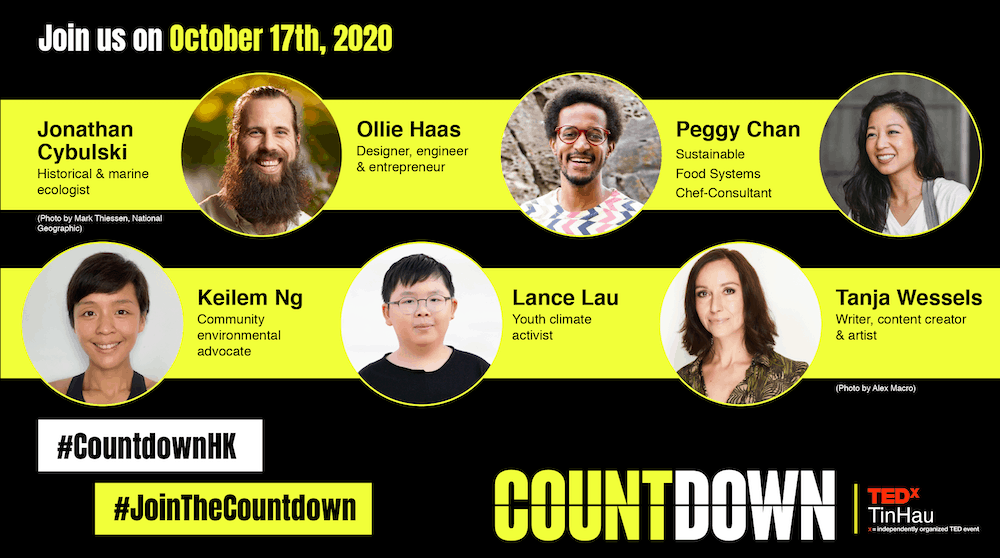In advance of the TEDxTinHau Countdown event in Hong Kong on 17 October, we chatted with the line-up of inspirational speakers to identify the climate solutions they believe will help shape the future of our planet.
When it comes to the climate crisis, identifying solutions is not a problem. Across the globe, there are a tonne of incredible humans creating crazy but cool inventions solving the world’s environmental problems. In addition, Project Drawdown’s latest report identifies no fewer than 76 legit solutions at our fingertips to solve the climate crisis. We know exactly what needs to be done, and we have the technology to do it. So why don’t we take action?
If you’re Hong Kong-based and want to hear more about the people, ideas, and actions that are making a positive impact on our planet add the TEDxTINHAU Countdown climate event to your calendar. Taking place on Saturday 17 October, the event will bring together six incredible Hong Kongers sharing fresh sustainability ideas that will help shape a greener future. Covering the core themes of energy, transport, materials, food, and nature, expect to walk away with more than a glimmer of optimism for the future.
In advance of the event, we caught up with each of the speakers and asked for their thoughts on the climate solutions they believe will help drive tangible change. Here’s what they had to say.

Ollie Haas | Designer, engineer, and entrepreneur
Can we make flying more sustainable? If the airline industry was a country it would rank as the 6th largest emitter of CO2 globally. Planes give us unrivalled access to exploring and connecting with the world, but they also contribute hugely to our personal carbon footprint. As an aviation nerd, engineer and entrepreneur, I have become obsessed with resolving this conflict. The best you can do today is to buy carbon offsets for your flights. This is not a perfect solution but a necessary bridge until we develop better technology. Thankfully, this technology is on the near horizon: electric planes, sustainable fuels and hydrogen-powered aircraft will help to drastically reduce the environmental impact of flying. Each has its limitations. With current battery technology, for example, electric planes will initially be confined to short-haul flights. Sustainable fuels and hydrogen will require significant investment to scale production and develop infrastructure. However, none of these limitations are impossible to overcome. Even if we start small, that is progress in the right direction. If we keep pushing the bar, we can make flying more sustainable!
Tanja Wessels | Writer, content creator, and artist (and Green Warrior!)
How do we create better relationships with materials, and tell a better story – today and tomorrow? We have a dysfunctional relationship with materials, and it’s not our fault. From a young age, we are taught to celebrate people and occasions with gifts. We shop for stuff to alleviate uncomfortable emotions, including the need for approval, and attention. It’s a lifelong story we’ve been told by business, society, and media. On the one hand, we give materials a lot of time, energy and money. On the other, we are quick to discard and replace them with brand new ones. In the blink of an eye. Today the average consumer buys 60% more clothing items a year and keeps them for about half as long as they did 15 years ago. Where is the love?
Jonathan Cybulski | Historical and marine ecologist
The barriers to solving the climate change crisis are not physical, they are mental. The science, the data, the solutions – we know what they are. However, we need to find a way to create EMPATHY in order to initiate ACTION. We need people to stay dedicated to change, rather than starting various initiatives that fizzle out as quickly as they begin. Surprisingly, my work as a coral biologist and environmental scientist isn’t the main expertise where I draw hope and inspiration for creating sustained climate solutions. Instead, I look to my background in competitive athletics, and the mentality I have shaped throughout my physical fitness career to discuss how it is going to shape peoples “climate fitness” futures. Although you may not think burpees and climate change have much in common, I believe that when we shape our minds to think more like athletes – that is when we will really initiate consistent climate actions.
Keilem Ng | Community environmental advocate & Lance Lau | Youth climate activist
There are many ways to engage in the climate emergency and we believe that everyone has a part to play. While both of us do things that sound very official, like running the small NGO Eco Marine, and starting the Fridays for Future Hong Kong movement, neither of us are experts. We believe that you need to engage different people in different ways to help them find how they want to take action. From helping people build environmentally-friendly activities into their hobbies, like trail and beach clean-ups, to confronting people on the street with climate strikes. We want to bring environmental consciousness to different communities within Hong Kong and open up new channels for people to engage, while also inspiring people to start taking action, any action, because there is no time to waste and no action is too small to start with.
Peggy Chan | Sustainable food systems chef-consultant
To solve the climate crisis, we must prioritise equipping every single person with good food literacy. Only with basic skills, knowledge, self-efficacy and the confidence to ask the right questions, are we able to then decipher the most harmful from the least harmful foods, both to human health and our planet. It’s only then can we understand that our food system is entirely interconnected, that one person’s purchasing decision affects how food is grown. Only with a population that is equipped with stronger food knowledge can we then demand for regulatory changes and accountability.

